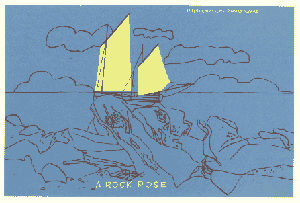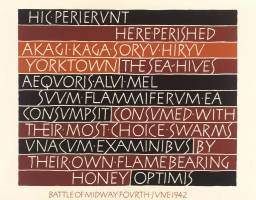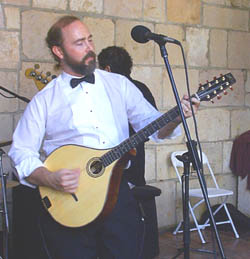
|
Jacket 15 — December 2001 | # 15 Contents
| Homepage | Catalog | |
Mark ScrogginsThe Piety of Terror:Ian Hamilton Finlay, the Modernist Fragment, and the Neo-classical SublimePerhaps we cannot creatively ruin the great work of time This piece is about ten printed pages long. |
|
|
 Ian Hamilton Finlay |
|
In the very public conflict between these two poets,[Note 1] high modernism — the poetic revolution represented in England and America by Eliot, Pound, and Moore — comes face to face with a postmodernism that presents itself as nemesis or critique, rather than as fulfillment or continuation. That MacDiarmid, a modernist poet of the stature of an Eliot or a Pound — not to mention the unquestioned progenitor of Scots poetry in the twentieth century — would completely bar Finlay’s work from the very category of poetry, is indicative of the extent to which Anglo-American (though not French or Russian) literary modernism, even as it destabilizes the generic boundaries between prose and poetry, fiction and non-fiction, nonetheless jealously guards the boundaries between the literary and the visual arts. The visual arts, far from being the favored site of cross-generic experimentation — as they are for such continental poets as Apollinaire — represent for MacDiarmid and other Anglophone modernists a transgression beyond the limits of the literary, beyond the bounds of a "tradition" that, however it might be altered and expanded, remains a fundamentally verbal one. |
 Ian Hamilton Finlay |
|
One key to the complex balance of verbal and extraverbal elements that makes up Finlay’s work, and perhaps an indication of why MacDiarmid rejected that work so vehemently, lies in the notion of the textual fragment, both as it is originally theorized by the Romantics, and as it is appropriated and altered by the high modernists. Without monolithizing either of these disparate groups, I would like to compare Finlay’s use of ostensibly fragmentary, linguistic structures with what I see as representative uses and theorizations of the fragment by poets before him. The continuities and contrasts cast light upon Finlay’s overall project and upon the relationship of that project — critical, destructive, and simultaneously retrospective — to the cultural projects of earlier eras and artists. The fragment, that is, so often fetishized and nearly glorified in Romantic and Modernist practice, becomes a crucial index of the distance between Finlay’s postmodernism/neo-classicism and the cultural moments upon which his praxis is built. |

Ian Hamilton Finlay |
|
What such a quest for such classical — or more accurately, neoclassical — wholeness would indicate is that there is in Finlay’s work an ethical element that can be obscured by no amount of postmodernist irony (though such irony, often in the form of outright humor or sarcasm, is everywhere present in his poetry). His restless experimentation in form and media, his avant-gardism, coexists with a severe, almost puritanical classicism and a moral traditionalism: this is clearest in his decades-long and consistent valorization, against the grain of everything that postmodernist poetry and art seems to stand for, of the aesthetic — the beautiful — as the aim of the artist/poet. The Monteviot Proposal, for instance, clearly aims to create a garden that is beautiful in the balance of its proportions, the harmony of its elements — beautiful in a quite traditionally classical sense. |
Footnotes
(Note 1) One can see the transatlantic repercussions of the clash in Lorine Niedecker’s correspondence with Louis Zukofsky; in 1962 she transcribes a letter from Finlay in which he recounts MacDiarmid’s attack on Finlay’s periodical Poor. Old. Tired. Horse. (Penberthy, Niedecker 313). See also Penberthy, "A Posse of Two."
(Note 2) Jerome McGann (Black Riders) and Cary Nelson have drawn attention to the works of Bob Brown; McGann (The Textual Condition) and Lawrence Rainey have studied the universally ignored visual dimensions of the early publications of Pound’s Cantos.
(Note 3) For a voluminous and perspicacious survey of the theme of fragmentation and ruin in Romantic thought, see the introduction of Thomas McFarland’s Romanticism and the Forms of Ruin (pp. 3-55).
(Note 4) Robert Rosenblum’s Transformations in Late Eighteenth Century Art is the single most complete examination of the manner in which the French Revolution adopts neoclassical imagery and techniques. A useful study of Revolutionary neoclassicism as it impinges upon Romanticism is Starobinski’s 1789: The Emblems of Reason.
(Note 5) Finlay, of course, as the public reaction to this piece showed, lays himself open to misreading. As recently as the spring of 1995, an extremely prominent American L=A=N=G=U=A=G=E poet — someone known for the sophistication of his political analyses — would in conversation with me dismiss Finlay’s work altogether, insinuating that Finlay’s examination of the iconography of the Third Reich rendered his work as a whole somehow suspect. Finlay’s use of Nazi iconography, according to him, was of a piece with a more generalized swing to the right in Great Britain during the 1970s; it had no deeper analytic quality, and was quite as reprehensible, as the adoption of Nazi paraphernalia by late-seventies right-wing punk bands. The poet, I now realize, was simply replicating MacDiarmid’s earlier gesture.
|
Works Cited
Abrioux, Yves, Ian Hamilton Finlay: A Visual Primer. Introduction and Commentaries. Stephen Bann. Cambridge, MA: MIT Press, 1992.
Davenport, Guy, trans., Archilochus, Sappho, Alkman: Three Lyric Poets of the Seventh Century B.C., Berkeley: University of California Press, 1980.
Finlay, Ian Hamilton, Inter Artes et Naturam. Paris: ARC, 1987.
Kenner, Hugh, The Pound Era. Berkeley: University of California Press, 1971.
Lacoue-Labarthe, Philippe, and Nancy, Jean-Luc, The Literary Absolute: The Theory of Literature in German Romanticism. Trans. Philip Barnard and Cheryl Lester. Albany: State University of New York Press, 1988.
MacDiarmid, Hugh, Letters. Ed. Alan Bold. Athens: University of Georgia Press, 1984.
McFarland, Thomas, Romanticism and the Forms of Ruin: Wordsworth, Coleridge, and Modalities of Fragmentation. Princeton: Princeton University Press, 1981.
McGann, Jerome J., Black Riders: The Visible Language of Modernism. Princeton: Princeton University Press, 1993.
___, The Textual Condition. Princeton: Princeton University Press, 1991.
Nelson, Cary, Repression and Recovery: Modern American Poetry and the Politics of Cultural Memory 1910-1945. Madison: University of Wisconsin Press, 1989.
Penberthy, Jenny, Niedecker and the Correspondence with Zukofsky, 1931-1970. Cambridge: Cambridge University Press, 1993.
___, A Posse of Two: Lorine Niedecker and Ian Hamilton Finlay. Chapman 78-79 (1994): 17-22.
Rainey, Lawrence S., Ezra Pound and the Monument of Culture: Text, History, and the Malatesta Cantos. Chicago: University of Chicago Press, 1991.
Rosenblum, Robert, Transformations in Late Eighteenth Century Art. Princeton: Princeton University Press, 1967.
Schlegel, Friedrich,Philosophical Fragments. Trans. Peter Firchow. Minneapolis: University of Minnesota Press, 1991.
Starobinski, Jean, 1789: The Emblems of Reason. Trans. Barbara Bray. Charlottesville: University of Virginia Press, 1982.
|

Mark Scroggins (left) is coeditor of Diæresis Chapbooks, and his life of Louis Zukofsky will be published by Wesleyan University Press. |
|
Jacket 15 — December 2001 Contents page This material is copyright © Mark Scroggins
and Jacket magazine 2001 |